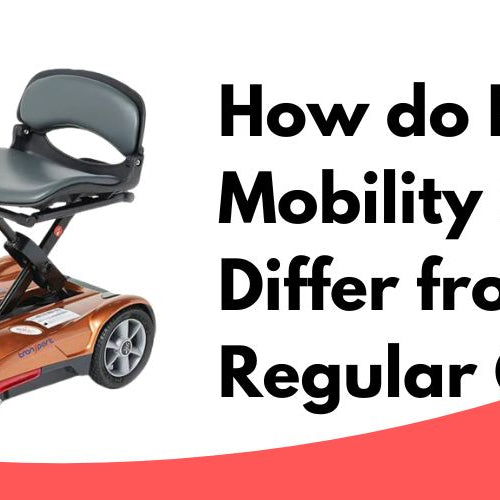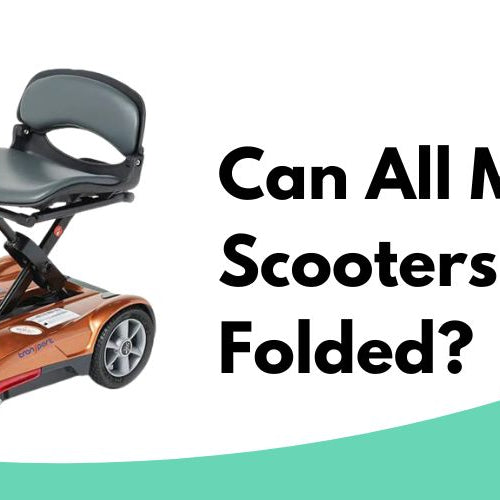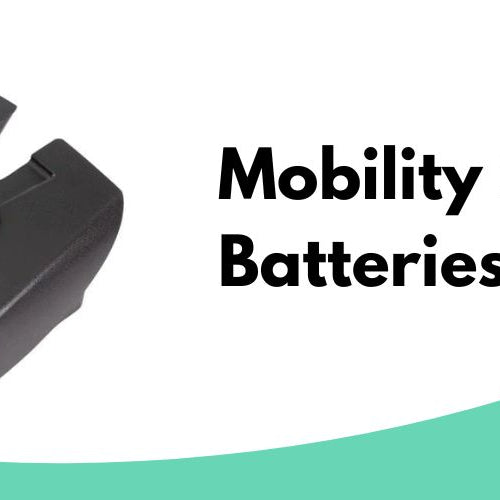Three-wheeled mobility scooters are becoming an increasingly popular mode of transportation for those who value convenience and independence. These innovative vehicles provide comfort while navigating various terrains and are specifically designed for individuals who may have mobility limitations. As their prevalence increases, potential users and caregivers alike may wonder about the safety of these scooters.
Safety is a crucial factor when considering any mobility aid, and three-wheeled scooters are no exception. These vehicles are built with stability and ease of use in mind, featuring a compact design, lower center of gravity, and intuitive controls. However, it's essential to acknowledge that the safety features of these scooters can vary by model and manufacturer. Some may include additional elements such as anti-tip wheels, enhanced suspension systems, or even advanced braking technology.
To determine the overall safety of three-wheeled mobility scooters, one must also look at the user's responsibility in operating them. Proper maintenance, obeying traffic rules, and utilizing necessary safety gear like helmets contribute significantly to the safe use of these vehicles. When considering a three-wheeled scooter, it's essential to assess the individual's physical abilities, the vehicle's specific features, and what precautions can be taken to ensure a secure and enjoyable experience.
The Popularity of 3-Wheeled Mobility Scooters
Benefits for the Elderly and Disabled
3-wheeled mobility scooters have become increasingly popular among the elderly and disabled individuals due to their ability to provide a comfortable means of transportation. One notable model, the Vive 3-Wheel Mobility Scooter, has been specifically designed for this demographic, with a top speed of 3.7 mph, padded armrests, and a comfortable seat, providing users with a safe and secure means of transportation.
The tight turning radius on 3-wheeled scooters is another significant benefit. For example, the Victory 10 3-Wheel model has a 42-inch turning radius, making it much easier to navigate tight spaces such as narrow hallways or crowded shopping centers. This advantage allows elderly and disabled individuals to maintain their independence and participate in daily activities with ease.
Ease of Use
Operating a 3-wheeled mobility scooter is generally quite simple, due in part to the ambidextrous lever system found on many models, like the Pride Travel Pro Premium. This feature enables users to control their scooter's speed and direction with either hand, accommodating a wide range of users' abilities and preferences.
Additionally, 3-wheeled scooters typically have more straightforward control panels, allowing users to easily adjust their scooters' settings, such as speed or power. These user-friendly features make 3-wheeled mobility scooters an excellent choice for individuals who may have limited dexterity or cognitive abilities.
Comfort
Comfort is a priority at Mobility Nest when it comes to mobility scooters, and 3-wheeled models are no exception. Many models, such as the Pride Go Go Sport, offer upgraded batteries for a longer driving range. This extended range allows users to travel longer distances without needing to stop and recharge, ensuring a more comfortable experience overall.
Moreover, 3-wheeled mobility scooters often have more extensive seating options and padded armrests, ensuring a pleasant ride for users of all ages and abilities. The combination of features like tight turning radius, easy-to-use controls, and comfortable seating highlights the ongoing popularity of 3-wheeled mobility scooters in providing a safe, comfortable, and convenient means of transportation for elderly and disabled individuals.
Safety Concerns and Considerations
Stability and Tipping Hazards
Three-wheeled mobility scooters are designed for individuals with limited mobility and are generally considered to be safe. However, there are some potential stability issues when compared to their four-wheeled counterparts. Because they have a single front wheel, steering on three-wheeled scooters can feel less stable, especially when making sharp turns. Additionally, the three-wheeled design can sometimes lead to tipping hazards, particularly on uneven terrain or when operating at higher speed.
Accident Data and Common Causes
While specific accident data for three-wheeled mobility scooters is limited, some general information can be gathered on common causes of accidents. These might include rider error, equipment failure, and external factors such as poorly maintained surfaces or obstacles on the path. In many cases, accidents can be attributed to:
- Loss of traction or control due to wet, icy, or uneven surfaces
- Sudden steering maneuvers or abrupt stops
- Collisions with pedestrians, bicycles, or other mobility scooters
- Faulty brakes, tires, or lights
It's essential for riders to be aware of these potential risks and to regularly check and maintain their scooter for optimal safety.
Safety Tips for Riders
To ensure a safe and enjoyable experience on a three-wheeled mobility scooter, riders should consider the following safety tips:
- Always wear a helmet and consider adding additional protective gear, such as knee and elbow pads
- Maintain a moderate speed and be extra cautious on uneven terrain or when making sharp turns
- Utilize bike lanes whenever possible and avoid areas with heavy pedestrian traffic
- Remain vigilant for potential obstacles and maintain a safe distance from other riders, pedestrians, and vehicles
- Ensure that the scooter has functioning lights for use in dim or dark conditions
- Regularly check and maintain the scooter's brakes, tires, and other essential components
- Develop good riding habits, such as always keeping both hands on the handlebars and using proper hand signals when turning
While three-wheeled mobility scooters come with unique safety concerns, riders who are mindful of these risks and take precautions can enjoy a versatile and efficient mode of transportation that provides independence and increased mobility.
Regulations and Legal Issues
Licensing and Testing Requirements
When it comes to three-wheeled mobility scooters, it is essential for users to understand the licensing and testing requirements. Generally, mobility scooter users do not need a driver's license, as it is considered an assistive device rather than a motor vehicle. However, it is crucial for users to read the manual and learn the operation principles and safety guidelines before using the scooter.
Laws Governing Mobility Scooter Use
Laws related to mobility scooter use vary from municipality to municipality. In most cases, there are no strict regulations against using mobility scooters in public spaces. However, certain federal laws, such as the Americans with Disabilities Act (ADA), require entities to allow people with disabilities who use mobility scooters into all areas where the public is allowed. It is important to familiarize oneself with local laws and regulations related to mobility scooter use to ensure compliance.
Interaction with Cyclists and Pedestrians
When using a three-wheeled mobility scooter, it is essential to recognize that the scooter will interact with cyclists and pedestrians in shared spaces. Understanding how to safely navigate these interactions is critical to the safety of everyone involved. Some basic rules of thumb include:
- Always yield to pedestrians: Give them the right of way and maintain a safe distance.
- Follow traffic flow: Stay on the right side of the path or sidewalk, and obey all traffic signs and signals.
- Use caution around cyclists: Give cyclists enough space, and be alert to their movements as they may pass by quickly or unexpectedly.
- Stay visible: Use lights and reflectors during low-light conditions, and consider wearing bright colors or adding a flag to increase visibility.
By understanding these licensing and legal issues, as well as practicing safe interaction with cyclists and pedestrians, users of three-wheeled mobility scooters can ensure a safe and enjoyable experience.
Technological Advancements in 3-Wheeled Mobility Scooters
Battery Life and Charging Options
Over the years, 3-wheeled mobility scooters have undergone significant advancements, particularly in battery technology. Modern scooters are equipped with long-lasting batteries that reduce the frequency of charging, allowing users to travel longer distances without worrying about running out of power. These batteries also tend to charge quickly, further minimizing downtime between uses. Users can often choose between standard and fast-charging options, depending on their individual preferences and needs.
Smart Features and Connectivity
Another significant improvement in 3-wheeled mobility scooters is the integration of smart features and connectivity. These scooters are now being equipped with various smart technologies such as GPS, Bluetooth, and mobile app compatibility, allowing users to access various scooter-related functions through their smartphones. As a result, users can now easily plan their routes, track their scooter's location, check battery levels, and monitor their driving patterns, all using a simple app.
Traction and Stability Improvements
Ensuring safety while driving has always been a priority of mobility scooter manufacturers, particularly in the case of 3-wheeled scooters. To enhance stability, 3-wheeled mobility scooters now come with innovative features like better shock absorbers, improved suspension systems, and anti-tip wheels. With these advancements, scooters can provide a more stable and comfortable ride on uneven surfaces or slopes, ensuring users stay safe.
Traction is another essential factor to consider when it comes to the safety of 3-wheeled mobility scooters. Many models now come with improved wheel designs and better grip, allowing users to navigate various terrains easily. Some scooters have even adopted the use of non-pneumatic tires, which don't require air and remain puncture-proof, further improving traction and reducing the risk of accidents.
In summary, technological advancements in the field of 3-wheeled mobility scooters have led to safer and more user-friendly options for individuals looking for extra assistance in maintaining their mobility. These advancements have made it possible for users to enjoy improved stability, traction, and connectivity while using their scooter, ensuring they can travel safely and comfortably.
Buying and Renting Options
Cost Considerations and Financing
When it comes to buying or renting a 3-wheeled mobility scooter, cost is an important factor to consider. Prices can range widely, and it is essential to find a scooter that fits the user's budget and needs. There are various financing options available, such as financing through the scooter manufacturer or a third-party lender. Buyers should also be aware of additional costs like maintenance, insurance, and replacement parts.
Renting Vs. Purchasing Mobility Scooters
Deciding whether to rent or purchase a 3-wheeled mobility scooter depends on the user's specific requirements and the duration of use. Renting a scooter can be an affordable option for short-term needs or occasional use. It allows users to try different models and find the one that best suits their preferences. Renting can also be suitable for those who are unsure if a 3-wheeled scooter is the right choice for their needs.
On the other hand, purchasing a scooter may be more cost-effective for long-term use. A purchased scooter can be customized to meet the user's specific requirements and upgraded as needed. It also gives the user a sense of freedom and independence, knowing they own the scooter.
User Reviews and Ratings
To ensure that a 3-wheeled mobility scooter is safe and meets the specific needs of the user, it is essential to check reviews and ratings from other users. This feedback can give insight into the scooter's performance, safety features, reliability, and ease of use. It can also help potential buyers identify any common issues or concerns with the scooter.
When comparing different scooter models, consider factors such as:
- Maximum speed
- Range on a single charge
- Stability and maneuverability
- Weight capacity
- Accessibility of replacement parts and service
In summary, when considering buying or renting a 3-wheeled mobility scooter, it is crucial to weigh the costs and long-term benefits of each option. User reviews and ratings can provide valuable insight into what to expect and which scooter model may suit the user's needs.
Adapting to Different Environments and Conditions
Using Mobility Scooters in Urban Settings
Three-wheeled mobility scooters provide an effective means of transportation for individuals with disabilities navigating an urban setting. As cities typically have more obstacles and uneven surfaces than suburban areas, it's important for users to pay close attention to their surroundings. In particular, crossing roads, maneuvering around pedestrians, and avoiding vehicles such as trucks and Uber rides can require extra effort. Utilizing a three-wheeled scooter, with its tighter turning radius, can make it easier to adapt to these urban environments, while also granting quick access to assistance if needed.
When visiting a restaurant or other public spaces, individuals riding mobility scooters should be prepared for different types of entryways, flooring, and layouts. These establishments should offer accessibility accommodations in accordance with legislation like the ADA, but some might require users to enter through a different door or ask staff for assistance.
Riding in Various Weather Conditions
Weather conditions can significantly impact the safety and performance of three-wheeled mobility scooters. In general, mobility scooters are designed to handle mild to moderate weather conditions. However, extreme heat or cold, heavy rain, or snow can affect their functionality or potentially cause harm to the user or the scooter. When operating the scooter in unfavorable conditions, be cautious of slippery and wet surfaces that can lead to loss of control or decrease in battery life. In extreme scenarios, consider postponing travel and seeking alternative methods of transportation, like a train, if possible.
Traveling with a Mobility Scooter
Mobility scooters are designed to offer a sense of independence for people with disabilities, and that includes traveling. Many mobility scooters can be disassembled into smaller pieces for transportation in a personal vehicle or even in the cargo section of a train. Choosing the right model, especially an electric scooter, can support easy transport while maintaining the user's autonomy.
When planning to travel by ocean, users must check whether cruise lines are equipped to accommodate mobility scooters. This may include available storage space, accessible cabin entrances, and scooter charging capabilities on board. Additionally, users should understand that not every location visited by the cruise may be accessible for scooter riders.
Finally, to ensure a safe and enjoyable experience, it's essential for users to maintain their mobility scooters properly. Regular inspections and upkeep will help to extend the scooter's longevity and performance, making it easier for individuals to adapt to various environments and situations.






Leave a comment